Migrant labourers in Kerala
 | |
| Total population | |
|---|---|
| 4 million (40 lakh) (2016) | |
| Regions with significant populations | |
| Ernakulam | > 800,000 |
| Kozhikode | >400,000 |
| Palakkad | >400,000 |
| Trivandrum | >750,000 |
| Other districts | ~2,000,000 |
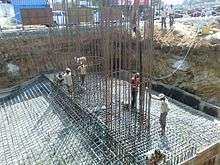
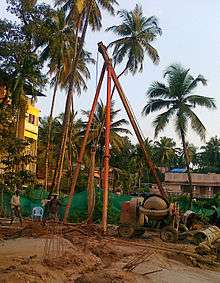
.jpg)
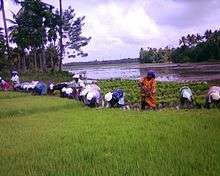
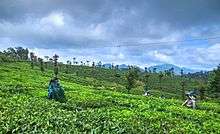
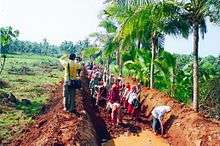

Migrant labourers in Kerala, India's southern most state, are a significant economic force in the state; there were around 2.5 million internal migrants in Kerala according to a 2013 study by the Gulati Institute of Finance and Taxation. Every year, the migrant worker population in Kerala increases by 2.35 lakh (235,000) people.[1] Despite their importance and despite many of them praising the state for its welfare schemes and environment[2], they are often ignored in comparison and suffer from comparatively poor living conditions.
Background
There are both economic and social imbalances among states in India and this leads to internal migration in general. High literacy rates, better education and lack of professional and skilled jobs had prompted Keralites to look for higher wages and skilled labour outside India. This trend then led to a decline in the availability of workforce in Kerala especially in unskilled jobs. Kerala has the lowest population growth rate in the country and is set to become the first state with zero population growth, or even with a negative growth rate.[3] The child population growth is currently negative at -8.44%. In less than a decade, the Keralite population is set to decrease.[4] Schools have been reporting vacancy of seats not because of drops in enrollment, but simply as there are no children to send. Therefore, with an ageing population like in Europe combined with the tendency of youth migrating abroad, the shortage of workers is bound to increase.
History
According to a study, Kerala is not able to create enough jobs that aresuitable for an increasingly larger number of young people with high levels of education. Although lack of jobs was the main reason for migration of Keralites before 2000, the notion of higher wages abroad has gained traction among Keralites even though currently the wages obtained in Kerala have became similar to those obtained abroad in many cases.[5] Additionally, the glamour associated with Gulf emigration is still very strong among the young in Kerala. This is an important factor in their decision to emigrate instead of working in the state.[6]. The Kerala Migration Survey (2014) conducted by the Centre for Development Studies, Thiruvananthapuram, found that the inability to generate employments to retain the educated youth was one reason why migration had increased – instead of dipping as forecast a few years earlier. But, several thousand educated youths have moved to the Gulf for low-skill jobs they wouldn’t do in Kerala.Migration therefore also takes place either because the locals have priced themselves out of the informal service sector, or, as in big cities like Mumbai, they have placed some tasks beneath them and migrants fill the gap.[7]
According to a 2013 study[8] conducted by Mr. M. P. Joseph IAS (R),[9] Dr. D. Narayana and Dr. C. S. Venkiteswaran on behalf of the Gulati Institute of Finance and Taxation for the Department of Labour and Skills of the Government of Kerala, there are over 25 lakh(2.5 million) domestic migrant labourers in Kerala from other states of India, as well as from Bangladesh and Nepal, in 2016 this figure stood over 40 lakhs (4 million) with an annual arrival rate of 2.35 lakhs with a sum of Rs 25,000 crores going outside the state each year as wages to the migrant workers.[10] According to official estimates, the expatriate Malayali population earns in excess of Rs. 75,000 crore annually. The number of migrant workers in Kerala is much larger compared to only 16 lakh (1.6 million) keralites working outside India [11] In 2013, the number of migrant workers in Kerala was almost one-tenth of that of the local population which was about 33 million in 2011. It is estimated to rise as high as 48 lakhs (4.8 million) by 2023 despite the decline of migration of Keralites to other countries. Besides, within 10 years, the majority of the local population would have aged above 40 years and this could lead to a further increase of migration from other states.[12] In many cases, the high linguistic, social and cultural differences of Kerala and these other states and the large distance makes it similar to international migration rather than internal migration.[13]
Possible causes
There are push and pull factors attracting migrants to Kerala. According to Dr. Manav Paul, the push factors are mostly poverty, unemployment, density of population, bad yield from agriculture, low demand for labourers and other factors like raising up families, lack of civil activities in the residential area, disasters, wars, internal fights on basis of caste, creed, race affect the flow of migrants to Kerala. Pull factors like better employment opportunities, standard of life in Kerala, high wages compared to other states, lesser communal clashes, high health indices, and provision of education for children also attract migrants to Kerala[14], as well as an ongoing labor shortage in Kerala and greater healthcare availability. However, despite these motivations, migrants often find that they are unable to access the same benefits as locals.[15]
High wages
Kerala currently offers the highest wages not only in India but also among the SAARC Countries. The high minimum wages with comparatively better living conditions in Kerala, even in villages, are often what motivates migrant workers, as the wages are often double or even more than three times than wages obtained in other major cities in India, which also have higher living costs.[16] This is often attributed to the socialist-leaning Kerala model of development and is a key attraction to the migrant labourers.[17] For agricultural work like ploughing and tilling, the average daily wage in Kerala was more than Rs 713, followed by Tamil Nadu at Rs 515. The lowest wage being paid in the country was Rs 187. In states like Bihar, Uttar Pradesh, Gujarat and Odisha, workers are usually paid wages of around 200 rupees, but which can be as low as 90 rupees. The wages for non-agricultural work is also much higher in Kerala. Carpenters and plumbers get wages which are two times the national wage average for their profession. The data shows that while the average wage ranges are between Rs 200 and Rs 300 for different professions in states across the country, employers in Kerala do not pay below Rs 600 for any job.[18][19] It is even said that a migrant labourer from Bihar, who would get Rs 40 at his native place, makes a minimum of Rs 600 in Kerala.[20][21] However, Keralite workers are paid even higher amounts and so, most of the times the local residents prefer the migrant workers because of the comparatively cheaper labour and also because the migrants work harder than the locals. Even though the wages for labour are high, the cost of living in the state is the same or even lower than in many other parts of the country. Over 70 per cent of them earn wages above Rs.300 per day. On an average, they remit Rs.70000 per person annually and the remittances are almost entirely through banking channels.[22]
However, according to the last NSSO Survey (2011-2012), in the category of major states, Kerala has the highest Unemployment Rate (UR). Kerala’s unemployment level is at 7.4% , while in other states it is below 4%. Even though the rate has declined over the years, a whopping 50 lakh (5 million) people are estimated to be unemployed in the state. The unemployment rate is lowest in Gujarat, at 0.5 per cent. However, Gujarat is a low paying state on daily wages. Reading the two reports together, one can infer that while migrant labourers are attracted by the high daily wages, the natives are not opting for these jobs. Literacy and higher levels of education too has contributed to this attitude of considering some jobs as not respectable enough for a highly educated person.[18]
As per a study in 2013, the expatriate Malayali population earns over 75000 crore (750 billion) rupees annually. These high inward remittances have increased the demand of local labour. According to a study conducted by GIFT, the migrant labourers in kerala send their homes approximately 17500 crore (175 billion) rupees.[17] or an average of Rs 70,000 per person per year. These remittances are almost entirely sent home via bank services.[15]
Education
The Kerala government is considering the development of a Skill Development Institute for migrant workers.[23] It has already established Indian Institute of Infrastructure and Construction in Kollam city[24] and new centres of Kerala Academy of Skills Excellence (KASE) will be opened soon in other districts.
Although a large number of the children of migrant workers are enrolled in government schools, the state education department has opened schools for the children of migrant workers under Sarva Shiksha Abhiyan. Region specific teaching curriculum has to be often adopted as the origin and languages of migrants always differ.[25]
Migrants are also taught reading and writing skills in Malayalam and Hindi through the state literacy mission.[26]
Health and social security
Kerala is the first State in India to enact a social security scheme for the migrant workers and the State is the first to provide benefits to the job-seekers from outside with the Kerala migrant workers' welfare scheme set up in 2010.[27] The police has started audits of migrant workers in cities like Trivandrum and Ernakulam through which biometric details have been captured and ID cards issued.[28] In 2016, a new insurance scheme called Awas was launched to provide social security to the migrant workers and also to act as their database and registry as the crimes involving migrant workers are also rising along with the population.[29]
Kerala currently offers free health care for all the migrant workers [30] and is planning legislation to address the migrant labourers issue with the "The Kerala Migrant Workers Social Security Bill".[31] The first official labour camp will also be opened for workers from the North and North eastern parts of the country in the Palakkad district which would accommodate about 1500 workers and camps will be established in all other districts in the next phase. The department also plans to start kiosks and call centres with people proficient in Hindi as staff to interact and understand the problems of the labourers. Migrant Suraksha Project is being implemented across the State under the aegis of the Kerala State Aids Control Society among migrant labourers since 2009 mainly to detect HIV+ cases among them and to create awareness and health cards also have been issued to the labourers.[32] Many private foundations have their own 'migrant suraksha projects'and even free medical camps which aims to improve the life of migrants working in the state.[33] Exclusive grama sabhas or village councils are planned for the migrant labourers to identify their issues and find solutions.[34]In 2017, the government announced a health insurance scheme for migrant labourers which included free treatment worth Rs. 15000 and medical insurance with accident coverage.[35]
Demographics
Authorities find it difficult to get an exact number since thousands of migrants are said to move through the state from one part to another every day and at least 1500 new migrants reach the state every week. While the bigger cities Trivandrum and Kochi continue to attract the largest number of migrants, smaller cities like Calicut and Quilon also have a sizeable number of migrant workers. According to the 2013 study, which was based on a Survey of the Domestic Migrant Labour coming into and leaving the Kerala, the remittances of migrant workers in Kerala to their home states are over Rs. 17,500 crores which is equivalent to 4 per cent of Kerala's gross domestic product.[36] To put this in perspective; while the total remittances to Kerala from Keralites abroad, including in the Middle east countries from Apr 2013-Mar2014 were Rs 72,680 crores,the amount of household remittances to Kerala from its citizens abroad during Apr-March 2014 was only Rs 15,129 crores which is lesser than the amount which the migrant labourers in Kerala send to their home states [37][15]
Migrant workers are a work force consisting almost entirely of single males aged between 18 and 35 years and are usually highly mobile within Kerala. According to a 2013 study commissioned by the government, every fourth male between the ages of 20 and 64 in the state is likely to be a migrant. Whereas 60 per cent of them work in the construction sector, they also work in the hospitality, manufacturing, trade and agriculture sectors. Their skills range from unskilled to skilled carpenters, masons, electricians and the like. Around 30,000 migrants have settled down permanently at Trivandrum and Kochi. Migrants now make around 65% of several private enterprises. In industries such as cashew, hotels, brick kilns, construction, quarries and fishing; their daily wages range from 400 to 900 rupees.[38] Despite the fact that many migrants are not from West Bengal or Bangladesh, they are often known as "Bengalis"[39]or "Bhais".[19]
Traditionally, the largest number of migrant workers in Kerala used to come from Tamil Nadu[40] with many Tamil colonies existing in Kerala and many of them having been integrated with the locals in Kerala. Although a few studies say that labourers from neighbouring states like Tamil Nadu far outnumber the others, the cultural similarities with Kerala makes them well integrated with the local population[41] Even though there are still a large number of workers from Tamil Nadu and Karnataka, the trend in replacement labour seems to have reversed [42] as according to the survey in 2013, 75 per cent of the migrant workers come from five states, namely West Bengal, Bihar, Assam, Uttar Pradesh and Odisha. A large number consist of workers from Jharkhand, Chhattisgarh, Madhya Pradesh, Rajasthan, Gujarat, Haryana, Uttarakhand and Manipur as well. The languages seems to have found ground in Kerala with many shops advertising themselves also in Hindi and instances of local transport buses displaying destination names in Bengali and even Oriya .[43] In Perumbavoor, one of the towns with the largest migrant population in the state(over 100,000 migrants), there are Bengali hotels, churches with gospels in Oriya and Imams from Bengal and Odisha who give their speeches in their respective languages, theatres playing Bengali, Assamese and Oriya movies as well as a Gandhi Bazaar and a Bhai Bazaar.[20]
According to S Irudaya Rajan, a professor and expert on migration studies at Thiruvananthapuram’s Centre for Development Studies (CDS), Kerala is a field to watch out how migration, ageing and demographics change the landscape.[44]
Origin statistics
| State | Percentage share |
|---|---|
| Uttar Pradesh | 14.83 |
| Assam | 17.28 |
| West Bengal | 20 |
| Bihar | 18.1 |
| Orissa | 6.67 |
| Others | 23.13 |
Source : Gulati Institute of Finance and Taxation
Statistics by district
| District | Population |
|---|---|
| Ernakulam | >800,000 |
| Trivandrum | >750,000 |
| Kozhikode | >400,000 |
| Palakkad | >400,000 |
| Thrissur | 250,000 |
| Kannur | 250,000 |
| Malappuram | 250,000 |
| Kollam | 250,000 |
| Others | 150,000 |
| Total | 4,000,000 |
Issues and challenges
Initially the Tamil population used to migrate in large numbers to Kerala but appropriate action by the Tamil Nadu government in providing welfare schemes has called many of them back. Tamils were generally accepted because of the cultural similarities. But migrants from other states often find it difficult to integrate due to large differences in culture,food habits, language and lifestyle[14], especially the local cuisine, which is not to many migrants' tastes do to the presence of coconut oil[21] Locals also experience problesms higher rents, which results in many local businesses no longer being viable, while renters cannot afford to pay their rent.[15]
Illegal migrants
The government is taking steps following the concern about public hygiene and the scare of insurgents and illegal migrants finding their way into the state, many of which apparently follow extremist causes.[21] There are a high number of migrants from Bangladesh , Nepal and Srilanka among other countries.
Bangladeshi migrants
Illegal migrants from Bangladesh have also been arrested in many cases where the migrants, who come under the pretext of being from West Bengal or Assam and as citizens of India. It is estimated that a large number of Bangladeshi illegal immigrants live in Kerala under the pretext of being from West Bengal[46] and the Kerala police has been finding difficult to identify as they often mingle with migrants from other states and disappear into the crowd.[47] It is estimated that about 20 million (2 crore) citizens of Bangladesh have crossed into India illegally in the last two decades alone.[48] and had even led to events like Assam Movement. In Kerala, this migration happens due to the high wages, quality living conditions but also due to the sizable muslim population in the state.[49] Anti national activities have been reported ; the latest in which in August 2016, a native of west Bengal was arrested for insulting the national flag and he was later found to be an illegal immigrant from Bangladesh. There is said to be major racket at the borders of West Bengal and Assam with Bangladesh which provides illegal migrants with identity cards.[50]
Education
The majority of the migrant workers do not have any special skills, while the state’s construction, hospitality and retail sectors among other areas demands a skilled work force. The unskilled migrant workers are unable to fill the skill gap. Skill development institutes have been proposed for setup in the state.[23] The poor enrollment of children from migrant families in schools and dipping literacy levels is also a concern in Kerala, which historically boasts the highest literacy rate in India.[51]
Health and social status
Some of the most important issues facing migrant workers include low-quality and illegal housing, which often lacks basic facilities such as bathrooms and kitchens, long work days of up to 10 hours, and long work weeks can also often be six or seven days. While migrants form a significant role in Kerala's prosperity, they do not receive much attention from the state government; this is especially important as they are usually not involved in unions and lack knowledge about their rights.[15] Migrants are also often absent from government documents; contracts between migrants and their employers are usually informal and unofficial.[21]
A study conducted in 2013 by the Gulati Institute of Finance and Taxation for the Kerala government has recommended that the government take steps to improve their housing and living conditions. Registration on arrival is also proposed. The report also suggests that the migrant labourers be brought under the ambit of Rashtriya Swasth Bhima Yojana.
There have also been concerns about the working conditions and long working hours of migrant labourers; this issue came to the forefront in regard to the plywood industry in Perumbavoor.[52] The introduction of health cards was also proposed due to diseases being found in migrant workers; these were then eradicated by the state. Because of the introduction of new diseases a proposal to screen all the workers is being made under the "Safe Kerala" campaign.[53]
Begging and human trafficking
Kerala has the lowest proportion of homeless people in India.[54] Once a rare sight, begging on the streets is on the rise. There also have been reports of child trafficking on the rise with many street children in Kerala from other states. Although Kerala does not have major industries with scope for potential child labour, small-scale industries, particularly based in cottages and quarters, are stealthily engaging children.[55]
Crime
The rising crime rate, with many crimes being attributed to migrant workers, has made their acceptance into the local community harder.[56] Perumbavoor and its adjoining areas in the Ernakulam rural area, which features the largest concentration of migrant workers in the state, has earned a prominent place in the state crime map.[57] During the last five years, 1,770 cases registered in the state in which migrants were accused. Drug trafficking, fake currency, robbery are the major crimes involving migrants, but there were brutal murder cases in which migrants were also involved.[58] In an analysis, out of 38 cases of murder reported in Perumbavoor area which has one of the largest number of migrant in the state in the last 5 years, 32 had links to migrant labourers and such a trend is observed in other parts of the state as well with only a few arrests made as the accused often flee the state.323 cases of crime are registered relating to migrant labour in the Ernakulam rural area alone in the last five years.[57] Kerala government has been trying to alleviate the fears of the local population in regard to this.[59]
However, some have alleged that local police forces are biased against migrants. One example is the death of a student who was raped, then murdered in Perumbavoor. This was blamed on migrants, despite evidence otherwise. Another significant incident is the tying of Kailash Jyothi Behra, an Assamese migrant who was accused of robbery, to a tree, which resulted in his death.[60]
See also
- Kerala Gulf diaspora
- Ethnic groups in Kerala
- Interstate Migrant Workmen Act 1979
- Illegal immigration to India
- Kerala model
References
- ↑ K, Rejimon (1 May 2017). "Left-led Kerala govt will be first in country to provide insurance, free medical treatment for migrant workers". Firstpost. Retrieved 10 May 2017.
- ↑ http://www.business-standard.com/article/economy-policy/kerala-a-dubai-for-bengali-migrants-111072700087_1.html
- ↑ Share on Twitter (2015-03-28). "Kerala to become 'zero population growth' state - Times of India". Timesofindia.indiatimes.com. Retrieved 2016-12-01.
- ↑ "Kerala Census: Child population declines". The Hindu. 2013-05-18. Retrieved 2016-12-01.
- ↑ "Election 2016: Can Kerala learn to respect its non-resident millionaires and Bengali immigrants equally? — Quartz". Qz.com. 2016-05-16. Retrieved 2016-12-01.
- ↑ "Kerala migration survey 2014: State’s youth still fly abroad for livelhood". The Indian Express. Retrieved 2016-12-01.
- ↑ http://www.firstpost.com/india/keralas-emigration-locals-disinclination-to-work-is-a-boon-for-interstate-migrant-labourers-3612913.html
- ↑ M. P. Joseph; D. Narayana; C. S. Venkiteswaran (2013). Study of Domestic Migrant Labour in Kerala.
- ↑ Menacherry, M. P. Joseph. "M P Joseph". www.mpjoseph.org.
- ↑ "Archive". Archive.indianexpress.com. 2014-01-15. Retrieved 2016-12-01.
- ↑ "Survey finds only 16.25 lakh NoRKs - Today's Paper". The Hindu. 2013-10-31. Retrieved 2016-12-01.
- ↑ "Study on the Domestic Migrant Labour in Kerala". Minister-labour.kerala.gov.in. 1946-01-26. Retrieved 2016-12-01.
- ↑ http://csesindia.org/admin/modules/cms/docs/publication/29.pdf
- 1 2 http://eprawisdom.com/jpanel/upload/articles/114am9.Dr.Norvy%20Paul%20VC.pdf
- 1 2 3 4 5 Ananda, Padmanabhan J (Jan–Feb 2016). "STATUS OF MIGRANTS FROM OTHER STATES TO KERALA – NEED FOR DEVELOPMENT INITIATIVES" (PDF). International Journal of Commerce, Business and Management. 5 (1): 25–28. Retrieved 13 June 2017.
- ↑ Sobhana K. (2012-10-04). "Kerala pay too irresistible for Bengal". Telegraphindia.com. Retrieved 2016-12-01.
- 1 2 Nair, Gouridasan (17 August 2015). "Migrants in the land of expatriates". The Hindu. Retrieved 10 May 2017.
- 1 2 "Some statistics that show why migrant labourers are flocking to Kerala". The News Minute. 2015-06-18. Retrieved 2016-12-01.
- 1 2 Babul, Bibin (30 April 2016). "Perumbavoor: A mini North India in Kerala". The Times of India. Times Group. Retrieved 13 June 2017.
- 1 2 Share on FacebookShare on Twitter (2016-04-30). "Perumbavoor: A mini North India in Kerala - Times of India". Timesofindia.indiatimes.com. Retrieved 2016-12-01.
- 1 2 3 4 Menon, Sreelatha (27 July 2011). "Kerala, a 'Dubai' for Bengali migrants". Business Standard. Retrieved 13 June 2017.
- ↑ "Microsoft Word - 4.IJCBM- article.doc" (PDF). Retrieved 2016-12-01.
- 1 2 http://indianexpress.com/article/india/india-others/kerala-government-proposes-to-set-up-skill-development-institute-for-migrant-workers/
- ↑ http://www.kase.in/kase_old_backup/newsdetails.php?id=16
- ↑ http://articles.economictimes.indiatimes.com/2014-11-20/news/56303951_1_study-centres-migrant-children-migrant-labourers
- ↑ http://www.business-standard.com/article/economy-policy/kerala-a-dubai-for-bengali-migrants-111072700087_1.html
- ↑ http://www.thehindubusinessline.com/news/variety/keralas-scheme-for-migrants/article6902317.ece
- ↑ http://www.thehindu.com/news/cities/Kochi/police-begin-audit-of-migrant-workers-in-city/article8895898.ece
- ↑ http://www.ndtv.com/kerala-news/kerala-to-bring-over-25-lakh-migrants-under-insurance-cover-1432884
- ↑ http://www.business-standard.com/article/economy-policy/kerala-a-dubai-for-bengali-migrants-111072700087_1.html
- ↑ http://articles.economictimes.indiatimes.com/2015-07-15/news/64449963_1_migrant-labourers-social-security-bill-state-police
- ↑ http://www.thehindu.com/todays-paper/tp-national/tp-kerala/corpn-extends-help-for-migrants-health-project/article8319951.ece
- ↑ http://www.thehindu.com/todays-paper/tp-national/tp-kerala/medical-camp-for-migrant-workers/article8558856.ece
- ↑ http://www.thehindu.com/todays-paper/tp-national/tp-kerala/grama-sabhas-planned-for-migrant-labourers/article8453862.ece
- ↑ "India: Free Health Care for Migrants in Communist-Led Kerala State". teleSUR. 2 May 2017. Retrieved 10 May 2017.
- ↑ Ravindranath, Karthik (2015-11-08). "Migrant workers send home 4 per cent of Kerala's GDP". English.manoramaonline.com. Retrieved 2016-12-01.
- ↑ "Migration still on the rise as job opportunities shrink in Kerala". The Indian Express. Retrieved 2016-12-01.
- ↑ V B Unnithan (2016-03-30). "40 lakh migrant workers - Rs 25k cr flowing out of economy every year - Kerala-Mathrubhumi Kerala News, Latest Kerala News, Kerala Breaking News, Kerala Politics". English.mathrubhumi.com. Retrieved 2016-12-01.
- ↑ Menon, Harish C. (16 May 2016). "Can Kerala learn to respect its non-resident millionaires and Bengali immigrants equally?". Quartz. Quartz Media LLC. Retrieved 13 June 2017.
- ↑ http://csesindia.org/admin/modules/cms/docs/publication/16.pdf
- ↑ http://www.csesindia.org/admin/modules/cms/docs/publication/16.pdf
- ↑ http://shodhganga.inflibnet.ac.in/bitstream/10603/21348/15/15_summary.pdf
- ↑ Sujith Bhakthan (2014-07-20). "KSRTC Bus with Bengali Destination Board in Malappuram - KSRTC Blog - Aanavandi Blog | Everything About Kerala RTC". KSRTC Blog. Retrieved 2016-12-01.
- ↑ "Election 2016: Can Kerala learn to respect its non-resident millionaires and Bengali immigrants equally? — Quartz". Qz.com. 2016-05-16. Retrieved 2016-12-01.
- ↑ http://www.mathrubhumi.com/print-edition/kerala/migrate-workers-in-kerala-malayalam-news-1.958770
- ↑ http://www.thehindu.com/news/cities/Kochi/steady-influx-of-illegal-immigrants-into-city-raises-concern/article4878162.ece
- ↑ http://www.hindu.com/2009/03/31/stories/2009033155411100.htm
- ↑ http://www.firstpost.com/india/bangladeshi-influx-larger-lankan-population-and-we-do-nothing-419993.html
- ↑ http://www.thehindu.com/todays-paper/tp-national/tp-kerala/7-bangladeshi-nationals-held/article6215283.ece
- ↑ http://www.oneindia.com/india/kerala-s-anti-nationals-and-how-the-migrants-add-to-the-problem-2171267.html
- ↑ http://www.thehindu.com/todays-paper/tp-national/tp-kerala/call-to-provide-education-for-children-of-migrant-labourers/article4194407.ece
- ↑ http://www.newindianexpress.com/cities/kochi/Plywood-Industry-a-Boost-for-Economy/2014/06/16/article2282545.ece
- ↑ http://www.dnaindia.com/india/report-migrant-workers-bringing-in-new-diseases-to-state-kerala-health-minister-2102849
- ↑ http://timesofindia.indiatimes.com/india/Population-of-homeless-in-rural-India-dips/articleshow/26981896.cms
- ↑ http://www.thehindu.com/todays-paper/tp-national/tp-kerala/rising-child-labour-leads-to-human-trafficking/article3814716.ece
- ↑ http://www.thehindubusinessline.com/news/states/spurt-in-crimes-involving-migrant-workers-rattles-kerala/article7252167.ece
- 1 2 http://www.newindianexpress.com/states/kerala/Kerala-Rising-Rural-Crime-Linked-to-Migrants/2015/07/09/article2910260.ece
- ↑ http://www.deccanchronicle.com/nation/crime/090616/migrant-workers-in-kerala-still-out-of-radar.html
- ↑ http://www.newindianexpress.com/cities/kochi/Drug-Trafficking-Cops-to-Step-up-Vigil-on-Migrants/2016/03/19/article3334744.ece
- ↑ Rajeevan, Revathi (5 May 2016). "Kerala: Migrant labourer dies after locals tie him to a tree under the sun". India Today. Retrieved 13 June 2017.